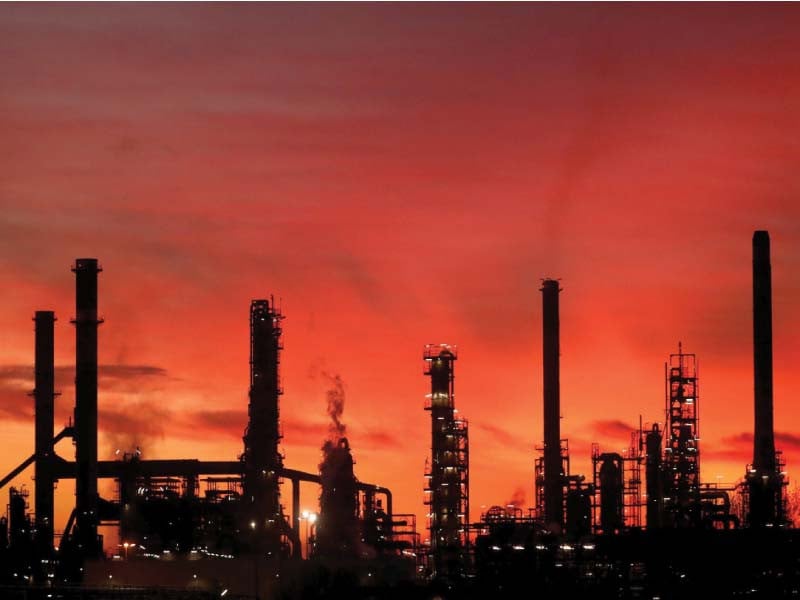NEW YORK:
Oil steadied on Friday following an earlier price spike of more than $3 a barrel after Iran played down a reported Israeli attacks on its soil, in a sign that an escalation of hostilities in the Middle East might be avoided
Brent futures were up 10 cents at $87.21 a barrel at 1430 GMT.
The front month US West Texas Intermediate (WTI) crude contract for May rose 27 cents to $83 a barrel. The more active June contract was up 15 cents at $82.25 a barrel.
Explosions were heard in the Iranian city of Isfahan on Friday in what sources described as an Israeli attack, but Tehran played down the incident and said it did not plan to retaliate.
“It was nothing but a big show, and so the markets deflated as quickly as they spiked,” said Tim Snyder, economist at Matador Economics.
Investors had been closely monitoring Israel’s reaction to Iranian drone attacks on April 13 that were in turn a response to an Israeli air strike on April 1 that destroyed a building in Iran’s embassy compound in Damascus.
Meanwhile, US lawmakers have added sanctions on Iran’s oil exports to a pending Ukraine aid package after Tehran’s missile and drone strike on Israel last weekend.
Iran is the third largest oil producer in the Organisation of the Petroleum Exporting Countries (OPEC), according to Reuters data. The International Monetary Fund (IMF) expects OPEC+ to begin increasing oil output from July, media reported on Friday.
OPEC+ members, led by Saudi Arabia and Russia, last month agreed to extend voluntary output cuts of 2.2 million barrels per day (bpd) until the end of June. That has helped keep oil prices elevated.
As oil’s risk premium has gradually unwound, prices have fallen around 3% since Monday and are set for their biggest weekly loss since February.
Investors, however, are not ruling out the possibility that Middle Eastern tensions will disrupt supply.
India’s oil dependency on Russia
Russia became the top oil supplier to India during the fiscal year 2023/24 for a second year in a row, squeezing the market share of Middle Eastern and OPEC producers to historic lows, ship tracking data from industry sources showed.
New Delhi has been gorging on Russian oil sold at a discount after Western nations shunned purchases and imposed sanctions on Moscow over its invasion of Ukraine. As a result Russia is now the top supplier to the world’s third-largest oil importer.
India has continued to buy Russian oil despite problems posed by a raft of sanctions aimed at reducing Moscow’s oil revenue to fund the war.
Russia is an ally of the OPEC but it has eaten into the share of India’s crude diet from key OPEC producers in the Middle East.
Russian oil accounted for about 35% of India’s overall 4.7 million barrels per day (bpd) crude imports in the fiscal year to March 31 compared with about 22% a year ago, the data shows.
India imported 1.64 million bpd of Russian oil in fiscal 2023/2024, up about 57% from the previous year, the data shows.
That lifted the share of oil from Russia, Kazakhstan and Azerbaijan, members of the Commonwealth of Independent States (CIS), in India’s imports to 39% in 2023/24 from 26% a year ago, the data shows. In contrast, the share of Middle Eastern oil in Indian imports fell to an all-time low of 46% from 55%.
Iraq continued to be the second-largest supplier to India followed by Saudi Arabia in 2023/24.
India imported an equal amount of oil from OPEC and non-OPEC nations for the first time in 2023/2024, the data showed.
The fall in Saudi oil imports followed higher official selling prices set by state-owned Saudi Aramco for most of the year, while imports from Kuwait have also dropped sharply after the producer diverted its crude to a new domestic refinery.
Published in The Express Tribune, April 20th, 2024.
Like Business on Facebook, follow @TribuneBiz on Twitter to stay informed and join in the conversation.
